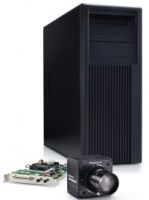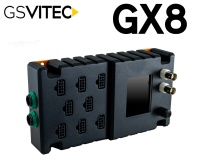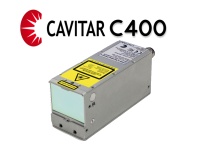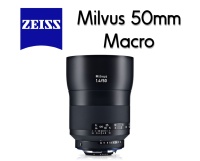- Description
- Specifications
- Videos
The Photron Crysta PI-1P polarization high speed camera is used to quantify and measure physical stress in transparent and semi-transparent fluids and solids. The Photron Crysta PI-1P polarization camera system can measure at 7,000 fps in full resolution operation or at 1.3 million fps when running at reduced resolution.
The Photron Crysta PI-1P high-speed polarization camera for the two-dimensional analysis of birefringence measurements, film thickness analysis, and surface roughness inspection, and is a powerful tool to understand phenomena such as birefringence, retardation, stress and impact fracture mechanisms of materials and fluids. This systems employ mechanical or electrical drives as polarization modulators, they require several photo-detection processes to measure polarization. In order to overcome this problem, The Photron Crysta PI-1P utilizes a high-speed 2D birefringence measurement system with a sampling rate of 1.3 MHz as the core device of the system with 16 parallel read out circuits in a matrix in the image sensor, which are connected to each pixel with individual A/D converters.
The image sensors design and fabrication incorporates a pixelated polarizer array which is made from photonic crystal bonded directly to the CMOS sensor, making the optical system in this sensor resistant to vibration. Each polarizer corresponds to each pixel of the image sensor with a one to one ratio. The size of each polarizer and pixel is 20 µm x 20 µm. In the polarizer array, groups of four neighboring polarizers (2 x 2) are set to have differing fast axis orientation at 0°, 45°, 90° and 135° in a clockwise arrangement. One polarization datum can be obtained by calculating detected light intensities from the four pixels of the image sensor. The parallel read-out circuit is arranged in a corresponding matrix.
The electric charges that represent the light intensities accumulated from each pixel are quantized by the multi-channel Analog/Digital converters and are stored in the memory of the camera. Once that is done. the software apply a phase shift analysis process to the stored data to obtain time-serial images of birefringent phase difference.
| 1024 x 1024 @ 7,000fps | |
|
Performance examples:
|
|
| 64GB | |
| 1,550,000 fps | |
| 369ns | |
| Gigabit Ethernet | |
| 12-bit | |
| Yes | |
| 2.98 sec at 1024 x 1000 @ 7500fps | |
| Global Electronic Shutter | |
| High-speed polarization image sensor | |
| 20 |
Related products
Export Disclaimer: Some goods on this site may be subject to US Export Regulations. Buyer agrees as one of the terms of purchase not to export such goods without having obtained and executed proper export licenses from the United States Government. Learn more.
 We offer a large variety of high speed cameras and brands that cover a large variety of applications.
We offer a large variety of high speed cameras and brands that cover a large variety of applications.
Photron has consistently expanded their range of high speed cameras to support the advancement of photo optics and electronic technologies, contributing to the progress of research and development in the fields of digital imaging and slow motion analysis. They cater to various markets including microfluidics, military testing, aerospace engineering, automotive, broadcast, particle image velocimetry (PIV), digital image correlation (DIC), ballistics testing, and more. As the leading global market provider of high-end, high-speed cameras, Photron continues to innovate and develop state-of-the-art products that are well-suited for demanding high-speed applications in industries such as automotive, military, aerospace, medical, scientific research, development, and manufacturing.
AOS Technologies is at the forefront of the industry as a premier producer of exceptional high-speed cameras and imaging systems. Our cutting-edge technology is utilized across the globe in challenging environments where precise and accurate high-speed recordings are essential. Our high-speed cameras offer the ability to capture intricate details of impacts, providing profound visual insights into accidents and events. These cameras are indispensable in various sectors such as industrial, automotive, defense, and space applications. AOS high-speed cameras deliver unparalleled insights into rapid mechanical movements, playing a fundamental role in facilitating accurate motion analysis.
Shimadzu ultra high-speed cameras feature the fastest cameras on the open market capable of motion sequences at ten million frames-per-second and 10 nanosecond shutter speeds. Medical science and engineering have made significant advancements thanks to visualization technology. For instance, we have seen the development of microscopes that can magnify observations of microscopic phenomena that are invisible to the naked eye. Additionally, X-ray inspection systems have allowed us to observe images using light at wavelengths that are imperceptible to us, and infrared cameras have provided further insights. Our eyes are limited in capturing events that occur in less than 50 to 100 milliseconds. Therefore, the use of high-speed video cameras has become essential to record these rapid occurrences and then play them back at a slower rate for visualization purposes. Serving as the go-to tool for visualizing ultra high-speed phenomena, the Hyper Vision high-speed cameras have played a crucial role in enhancing our understanding across various fields.





